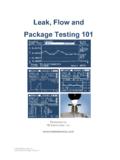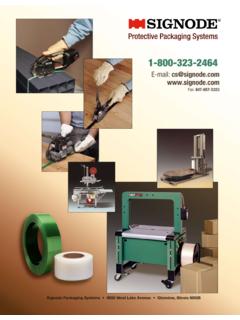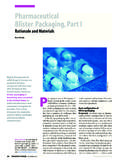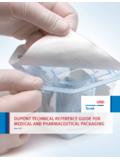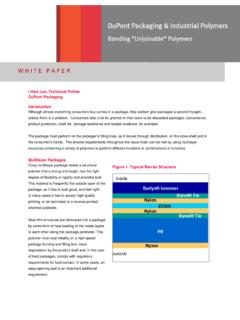Transcription of Testing Medical Device and Package Integrity - TM …
1 Testing Medical Device and Package Integrity Authors: Michael Franks, Stephen Franks - Electronics, Inc. 1999 Table of Contents Introduction: Objective Medical Device Testing : Step 1 Process Validation Planning Step 2 - Choosing the Testing Methodologies Leak Integrity Testing Methods Flow Integrity Testing Methods Step 3a - Pressure Decay Leak and Mass Flow Testing Pressure Decay Leak Testing Specifications Mass Flow Testing for Leakage Step 3b - Mass Flow Testing for Obstructions Mass Flow Testing Step 4 - Product Assurance Package Validation Testing : Step 1 Package Validation Planning Step 2 Choosing the Package Testing Methodologies Tensile Seal Strength Testing Inflation Seal Strength Step 3a.
2 Inflation Test Specifications Burst Testing Creep Testing Creep to Failure Testing Step 3b. Pressure Decay Leak Testing Step 4. Package Assurance Conclusion References Introduction Objective When a manufacturing firm produces a product designated for use in the Medical field, the company must supply one element regardless of part design: assurance. Through the use of in-line product Testing and final Package Testing , a manufacturer can document the steps taken to assure the end user that the product has been examined and has passed the standard Testing procedures designated by organizations such as the Food and Drug Administration (FDA), International Standards Organization (ISO), and American Society for Testing and Materials (ASTM).
3 A quality control department, therefore, must be aware of different Testing methodologies in order to gain this control and assurance over the production and packaging processes. This report examines different product and Package Testing procedures, focusing on the pressure decay leak and mass flow tests for product Integrity and seal strength and pressure decay leak Testing for Package Integrity . By implementing pressure decay leak Testing , mass flow Testing , and seal strength Testing to a quality control system, a manufacturer of Medical devices will gain control over their manufacturing process, and therefore gain quality assurance in the field. Medical Device Testing Figure 1.
4 The Medical Device Testing Process This figure represents the process followed when Testing the leak and flow Integrity of a Medical Device . This section analyzes each step of this chart, providing details as to the procedures and requirements for each step. Step 1 - Process Validation Planning According to the FDA, "Process validation is a requirement of the Current Good Manufacturing Practices Regulations for Finished Pharmaceuticals .. and of the Current Good Manufacturing Practice Regulations for Medical devices " [1]. With this statement, the FDA implies that any product intended for Medical use must incorporate a process validation plan into its manufacture. The FDA defines process validation in the following way: Process validation is establishing documented evidence which provides a high degree of assurance that a specific process will consistently produce a product meeting its pre-determined specifications and quality characteristics.
5 [1] According to this definition, a quality control (QC) program must first develop a written process validation guideline by which each step of the manufacturing process can be tested and recorded. Step 1 of the Medical Device Testing plan, therefore, includes the design of a written process validation plan. In addition to developing a process validation plan, Step 1 includes the material and design selection for the product. As with any product, the structure and material of the Device must serve the function. One consideration in this decision, however, again involves the process validation planning for the part. If the design does not lend itself to frequent Testing in the production cycle, it will not be able to satisfy the FDA requirements for "establishing documented evidence which provides a high degree of assurance.
6 " For example, the design of a multi-lumen catheter must permit each lumen to be tested during its production. The quality control Testing , therefore, must be able to be conducted on each leg of the catheter. When addressing the design issue in process validation planning, the FDA remains intentionally vague due to the large variety in Medical devices and their functions. Using phrasing such as "written manufacturing specifications and processing procedures shall be established," the FDA states the necessity of Testing without specifying the actual Testing methodology [1]. Instead of specifically stating that a certain test must be conducted, the FDA presents the method by which the Testing plan must be formed.
7 For example, the FDA states that "performance qualification Testing should include performance Testing under conditions that simulate actual use" [1]. By following guidelines and documenting a plan for process validation, a quality control team can satisfy federal regulations for assurance and industry standards for quality. Step 2 - Choosing the Testing Methodologies In addition to part design and material selection, forming a process validation plan includes the selecting of a Testing methodology during the production process. As Step 2 demonstrates, leak Integrity Testing and flow Integrity Testing encompass the two main categories of product Testing . As the next section explains, leak Integrity Testing includes many different methods, depending on the requirements and scope of the project.
8 Flow Integrity Testing , however, only includes one essential technique - the mass flow test. By sthe intended design and function of the test part, Integrity validation tests may be chosen to best suit the needs of the process validationplan. tudying Leak Integrity Testing Methods Leak Integrity Testing includes many different applications, ranging from a crude bubble test to a complex helium mass spectrometry test. Before the leak Testing methods are analyzed, however, leak Testing itself must be defined. According the Gary Elder, president of Gary Elder & Associates, a Medical Device Testing firm, leak Testing "is the evaluation of a component or system to locate leaks or to measure how much leakage will occur over a certain period of time" [2].
9 Extending this definition, Sherlock, author of the Nondestructive Testing Handbook lists three basic reasons for leak Testing : To prevent material leakage loss, which interferes with system operation To prevent environmental contamination hazards or nuisances caused by accidental leakage To detect unreliable components and those whose leakage rates exceed acceptable standards [3] From these definitions, as well as from Elder s comment that leak Testing should "assure product performance criteria are met," a manufacturer can conclude that leak Testing is a procedure that could satisfy the need for a standard quality control methodology [2]. In his article "Leak Testing , A Quality Assurance NDT Method," Elder clearly outlines the procedures necessary to create this type of leak Testing process plan.
10 This process begins by defining the leak test specifications, then proceeds to defining the leak test procedure, and finally ends the operation with the analysis of the leak test s performance [2]. Before beginning this process, however, the methodologies of different leak Testing procedures must be understood in order to make an informed decision as to which leak test to choose. The first leak test method developed was the bubble test. A crude operation, bubble Testing involves inflating a part and submerging it into a liquid bath. While submerged, a highly trained operator makes subjective judgments as to the location and leak rate of the bubbles emanating from the part. If the part passes the quality control standards for an acceptable part, the piece must then be removed from the bath and allowed to air dry before further processing or Testing may be conducted on this part.
